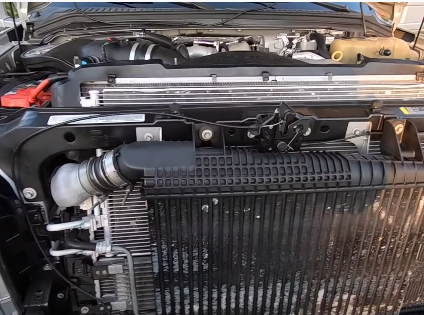6.4L Powerstroke EGR Delete: Things to Know
Searching the Internet for 6.4 Powerstroke will show that many vehicle owners have experienced fuel economy and performance issues. The 6.4 engine is excellent. The problem is the emissions. Owners who believe they are driving a 7.3 can have trouble maintaining their engines.
Although the 6.4 has its downfalls, you can support it properly. With minimal problems, we are seeing more people spend over 300k. These 6.4 can be a real headache if they are not taken under proper care. One of the ways to resolve this problem is to use the 6.4 Powerstroke EGR delete. EGR delete is the tampering-to-render-useless or outright removal of the exhaust gas recirculation valve.
The Problem With Emissions

The exhaust gas recirculation device mixes fuel and fresh air to return small amounts of exhaust gases to the intake manifold.
The intake manifold supplies fuel-air mixture to the engine, and its primary function is to distribute the combustion mixture evenly to maximize engine efficiency.
Why do automobile engines mix fuel and fresh air? Does this not seem counter-intuitive in reducing pollution?
Air comprises 21% oxygen (78% nitrogen and 1% other gases.
Oxygen is necessary for burning fuel in a combustion chamber. However, nitrogen is an inert or neutral gas. The static nature of nitrogen means that it doesn’t want to be changed or combined with other elements. It is content just as it is.
When the temperature of air and fuel in the combustion chamber increases, the degree of nitrogen also changes. Nitrogen oxide is formed when fuel and air are burned in the combustion chamber at high temperatures.
Nitrogen Oxide Emissions
The greenhouse gas, nitrogen oxide, contributes to climate change. Photochemical smog is caused by nitrogen oxide, which can block the skylines of many cities around the globe and engulf tall buildings in a mist.
California EGR Delete and Emissions Laws
EGR technology first appeared in automobiles in 1972. California was the only American state that required all registered vehicles to be equipped with an EGR. However, after California’s EGR mandate, the rest could follow suit through Federal Standards established by the Environmental Protection Agency.
Exhaust gas is also inert, which means that it can’t be burned again since 99% of its oxygen has been used. Inert gas is recirculated into the combustion chamber with a fuel mixture or fresh air thinning it. Also, the combustion chamber temperature is lowered by the exhaust gas to produce less NOx.
The EGR valve will bolt to the intake manifold. It must regulate the amount of exhaust gas in the combustion chamber. Otherwise, the engine will stall and run rough. The vacuum located underneath the carburetor’s throttle plates opens the EGR valve.
Ford Super Duty models received the 6.4L Power Stroke motor in the fourth quarter of 2007. The 6.4L’s predecessor, the 6.0L, did not fare well with critics. The issues with the engines have created a bad reputation with vehicle owners.
After the 2010 model year, the engine was replaced by a 6.7L Power Stroke. It was built with 350 HP and torque ratings up to 650 lb. ft. The machine also features a dual VGT compound turbo system. Air is fed into one turbo and the other into the larger turbo.
Owners of this Ford engine have had to deal with problems such as fuel system contamination, emissions control device malfunctions, and leaky radiators.
Clearing soot by the regeneration process didn’t work well for the diesel particulate filters. Like the diesel particulate filter, the EGR coolers on the truck were known to clog and crack. But EGR delete is that a valid argument? This engine’s problems are not limited to emissions control devices. You will be left scratching your heads if you have a problem with the fuel injection system or the turbochargers.
Below is a list of critical issues with the 6.4L Power Stroke Ford Engine.
- Due to the DPF regeneration process, the functionality of the piston rings in the seventh and eighth cylinders is compromised.
- Because of its speed, the water pump impeller causes the coolant to eject into the engine oil at high speeds. This rapid flow causes cavitation erosion on the front cover.
- The rocker arm tips can become damaged after 100,000 miles due to the increased pressure on the valve train.
- Turbocharger bearing seals can leak due to the high exhaust temperatures during the regeneration process.
- Oil leakage around the valves can be caused by a lack of bronze sleeves for the cylinder head.
- EGR cooler allows engine coolant to flow into the eight cylinders after turning off the engine. This navigation causes the cylinder to lock and bend the piston connecting rod when the vehicle starts.
- Modifications and repairs can be costly.
- Plastic clips and rocker oiling create a severe problem and can be a problem with non-DPF trucks that have been deleted.
- Exemplifying this is how aftermarket tuning of EGR delete can lead to unneeded fuel injection timing and cracking in cylinder heads due to high exhaust temperatures.
Major 6.4L Power Stroke Issues

It is important to emphasize that EGR delete alone will not fix any other problems you may have with your 6.4L Power Stroke. This inefficiency is because the federal EPA did not include a mandate for an emissions control device for these trucks’ models. Therefore, they were not well-engineered as the large truck manufacturers’ development teams were more concerned with complying with the new laws and pushing out their next model year than customer satisfaction and vehicle performance.
However, these issues and problems with emissions control devices have been solved over the years. Today’s vehicles are more efficient in reducing pollution and performing better. The 6.7 Power Stroke engine, for example, has served better than the previous models. Many engineering errors were reexamined and rectified.
These 6.4L engines have a lot to deal with, but deleting EGR can cause more problems. EGR delete has been blamed for many issues, including white smoke coming out of the exhaust and engine knock.
Conclusion
The 6.4L Power Stroke engine is a poor design. Even if EGR is deleted, there are still costly modifications to straight pipe the converters or diesel particulate filters.
If caught, the EPA will thoroughly fine you. We recommend that you avoid purchasing the 6.4L engine. If you do have one, consider upgrading to a 6.7L Power Stroke.


